So, you want to become a filmmaker? Maybe you’re a young dreamer like I was, maybe you’ve taken a liking to a new challenge later in life, or maybe you are somewhere in the middle.
Regardless, as a newbie filmmaker, you are going to need equipment. Films use audio and video like a painting uses paint and a canvas. Film is a visual and audio experience.
It may seem pretty obvious, but you’re going to need a camera and a device to record sound. Hooray! We have all of the tools, and this article is now going to be cut short. Well, not so much.
There are many other tools that help filmmakers achieve their vision. Your needs are going to determine what type of equipment you need to purchase.
Shooting a skateboard video isn’t going to require the same type of equipment as a corporate talking head video.
In this article, I will list some of my favorite tools for low-budget filmmaking. I’ll also explain how these tools can be used in different filmmaking scenarios, as well as provide some sample packages to help get you started.
1. An absolute must: a camera/lenses
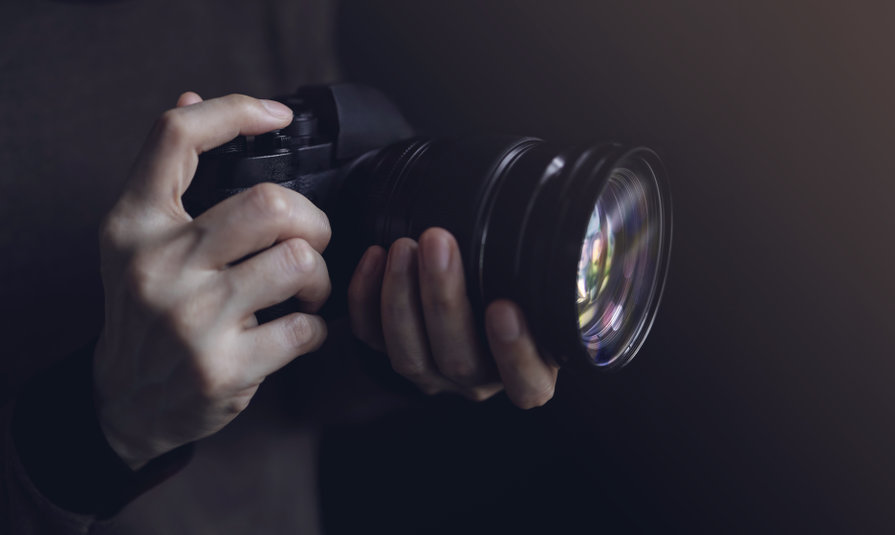
This might seem obvious, but you are going to need a camera. However, what kinds of things should you be aware of before purchasing a camera?
Here’s a list of items you should be thinking about.
Price
This will likely be your biggest concern when buying a camera. Great affordable cameras are constantly coming out, but there are a lot of companies that over promise and underdeliver.
I purchased my first camera for under $1,000, but that came with some drawbacks.
It’s best to do your research beforehand, but especially for cameras under $1,000. Cameras over $1,000 are generally a better starting point.
I recently published an article here naming five cameras that I think are great for beginner filmmakers. This will give you an idea of what to expect.
Functionality
This is really going to depend on what type of filmmaker you plan to be. Are you looking to become a vlogger?
Then you will want to find a camera that has a pop-out screen, has mic inputs, and offers in-body image stabilization (IBIS). Check out the FilmDaft essential vlogging gear checklist.
What if you shoot interviews or company profiles?
You’ll likely want a camera that offers 4K or more, a high dynamic range, and has a lot of inputs for accessories. Check out our guide to the best 5K and 6K affordable video cameras here.
The style of shooting you plan to do should determine which type of camera to buy.
There are plenty of cameras that can be a mix of everything a filmmaker might need, but this is something you should still keep in mind.
I would recommend making a list of the type of content you plan to shoot, and then researching cameras that fit your needs.
Storage
An area most newer filmmakers may not think about is storage. How are you going to record and store files?
Most cameras today use SD cards, but others can use CFast cards or SSD drives. Have a look at the typical file sizes you can expect for cameras you are interested in. Here’s a guide that talks about 4K video and SD card sizes.
Most cameras shoot in H.264 or a comparable codec that usually offers a reasonable file size – even when shooting 4K video.
Check out our guide to the best SD card for 4K video here.
However, the ability to record in ProRes or different Raw codecs is becoming more popular.
This leads to the need for a lot more storage because of the massive file sizes as well as having to purchase specific types of media storage devices.
For instance, a slow SD card will not work on a camera that records at a high bitrate.
Most cameras will have a list of recommended media storage devices listed on their website.
You can also check out our in-depth guide to memory cards and SSDs for video recording here.
Future upgrades
Cameras are constantly being upgraded. 4K is slowly becoming the new standard for film and video. Are these things you should be concerned about?
It depends. That’s why I recommend doing a lot of research before purchasing a camera.
You can also rent a camera from places such as LensProToGo to make sure you like what the camera offers before you buy.
I wouldn’t get too concerned about what future cameras may have to offer. As you grow as a filmmaker, your equipment will grow as well.
Lenses

Lenses are just as important, if not more important than the camera itself. A lot of consumer-level cameras will come with a lens, but more professional or cinema-grade cameras will not.
Cameras that are not full frame will come with some cropping on the sensor, known more commonly as crop factor.
For example, an MFT mount camera has a crop factor of two, so a 25mm lens will have the same field of view as a 50mm lens.
This can be a pro or con depending on your needs. I’ve personally been dealing with crop factor my entire career, and it hasn’t hindered my experience too much.
Zoom lenses will give you a lot of flexibility when it comes to focal lengths. However, the drawback to these is that the apertures usually don’t open very wide. A zoom lens in the 18-75mm range will be enough to get you started.
Prime lenses, which only have one focal length, are usually a better option because they can shoot in a lower aperture.
However, this will require you to buy more lenses. I personally have a mix of primes and zoom lenses. For example, I have an 11-16mm zoom lens, and a set of 35mm, 50mm, and 85mm prime lenses.
You also want to consider the lens mount on the camera. Mounts such as EF and MFT will give you a lot more options that are usually more affordable than mounts such as L, PL, or RF mount.
Lenses will also offer different features, such as image stabilization, electric aperture, manual aperture, and autofocus.
You’ll want to choose a lens carefully based on your needs.
Going back to previous examples, a vlogger will want to choose a zoom lens that has great image stabilization and auto-focus capabilities.
A video producer may want prime lenses for better depth of field capabilities and better low light with a wider aperture. Many videographers also prefer a cinema lens over a photo lens. Check out our guide to the best affordable cine lenses here.
You could also forgo buying an interchangeable lens camera altogether, but this isn’t a recommended option for serious filmmakers or video producers.
Accessories

I am not going to go into detail about each of these items, but here are some camera accessories that you are going to want to consider adding to your kit over time.
- AA/AAA Batteries – low priority
- Additional camera batteries and chargers – high priority
- Media cards – SD, CFast, SSD, etc. – high priority
- Camera bag – moderate priority
- Headphones – high priority
- Basic tool set – screwdrivers, Allen wrenches, etc. – high priority
- Tapes – masking, painters, gaffers, etc – low priority
- Monitors or recorders – moderate priority
2. The other absolute must: audio recorders and/or microphones
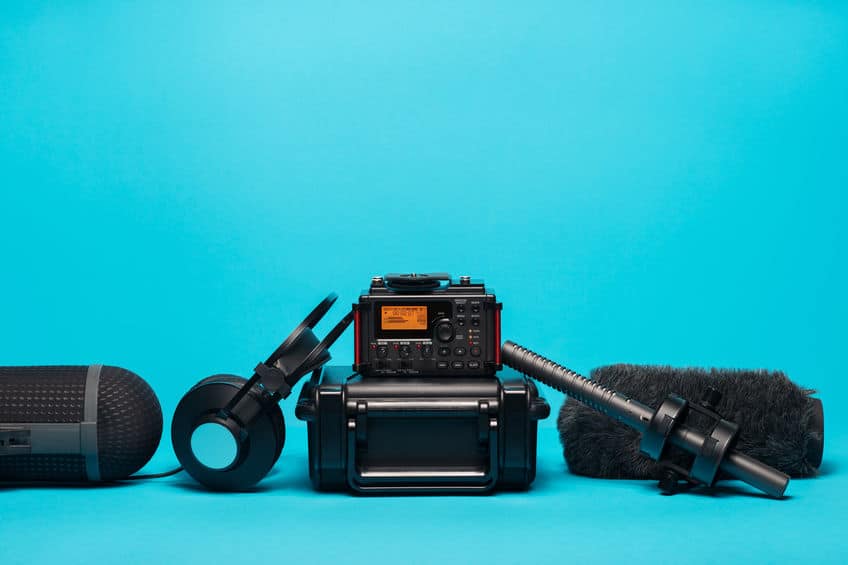
Having the ability to record audio seems obvious, but it can be often overlooked. Newer filmmakers will rely on the in-camera audio capabilities, which is understandable considering the cost of the camera.
Audio recorders – high priority
You should be considering purchasing some form of audio recording device. There are plenty of options from companies such as Zoom and Tascam that offer affordable recorders.
One popular model is the Zoom H1n which typically runs around $100. This is a portable audio recorder that has an attached microphone as well as a 3.5mm input for an external microphone.
One of my colleagues uses his H1n as a boom mic, standard audio recorder, and lavalier mic.
I have also used other Zoom models, such as the H4n and H6. Both of these allow for multiple XLR mics to be plugged in, attachments for using the recorder as a mic, and turning the recorder into an audio interface for a computer.
Read more about how to get good audio for video here.
On-camera mics – moderate priority
In some instances, you can forgo having an audio recorder if you can directly plug a mic into the camera.
Most cameras today have a 3.5mm jack built into the camera for this type of situation. In this instance, you can purchase a mic such as the Rode Video Mic.
This microphone can sit on the camera’s hot shoe and plug directly into a 3.5mm input. I’ve owned this mic before and turned it into a boom mic by purchasing a long male-to-female 3.5mm cable.
This isn’t the best method, but it is a great low-budget option. These mics are also compact, which is great if you don’t need high-quality audio and a compact setup.
Shotgun mics – high priority
Most cameras are not built for recording great sound. In that case, you would want to use an audio recorder in combination with a shotgun mic. A shotgun mic is a long microphone that looks like a thin tube.
These microphones typically have a super-cardioid pickup pattern. This basically means the mic will mainly pick up sounds in front of the mic and a little bit from behind.
These mics are the standard for recording sounds in movies, television, as well as client video work due to their clean sound quality.
Shotgun mics are not super compact. You’ll typically need someone to hold the mic on a boom, or set up the mic on some sort of boom stand. Check out our in-depth guide to shotgun microphones and boom poles here.
I have used a shotgun mic on top of a camera, but it’s not a fast, easy, or compact setup.
Check out our guide to some of the best shotgun mics here.
Handheld mics – low priority
Handheld mics are mics you would typically see in an onsite news report or live performance. These are not great for filmmaking but have their uses in the video world.
These mics are great for isolating voices, but the speaker has to be in very close proximity to the head of the mic. Again, these mics are not used in films but are worth mentioning for their other uses.
Lavalier mics – moderate priority
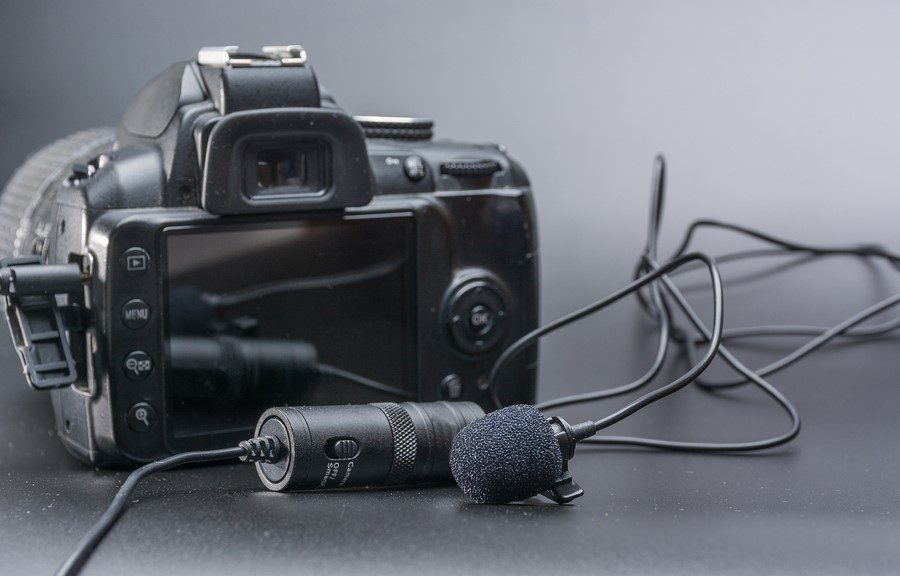
Lavalier mics are microphones that clip onto a speaker via an article of clothing or taping directly to the speaker’s chest.
Check out our guide to 5 inexpensive ways to hide your lavalier microphone under clothes.
These mics are great for recording clean sound on one speaker. Lav mics are used in a lot of films and TV shows in combination with a shotgun mic.
A show like The Office uses lav mics on all of the actors as it would be impossible to record clean sound in that setting with a shotgun mic.
Lav mics are also great for interviews or weddings when you need the vocals of the speaker to be the main focus. Lav mics can be a bit pricey, but companies like Rode and Tascam make affordable options.
The Rode Go mics can be plugged directly into a camera’s 3.5mm input. The Tascam DR-10L is both a recorder and a lav mic.
Check out our test of some popular wireless lavalier microphones here.
Lav mics are not great for recording much else than a speaker in close proximity, so it shouldn’t be your only mic source.
3. A must with some wiggle room: lighting

Lighting is very important when it comes to film and video. Even high-end cinema cameras like the RED MONSTRO or Arri Alexa cannot see in the dark.
You are going to want some lights and accessories to get you started.
Lights – high priority
There are plenty of affordable light kits available from companies like Neewer or Aperture that can get you started.
I love battery-powered LED lights because of how quick they are to set up, but they can get a bit pricey. You can easily go to your local hardware store and pick up available lights as well.
I personally recommend having a few lights on hand regardless of what you decide to use.
Three lights should be the minimum to get you started. Look for video or photography lights 45 watts and above. You can get away with using less wattage or lumens, but you’ll likely need a lot more lights.
You will also need to purchase a light socket if purchasing a single light bulb. Most photo or photography kits will come with these.
Light stands – high priority
This seems obvious, but not every light is going to come with a light stand. There are plenty of cheap light stands available on Amazon.
Cheap light stands are great if you need something affordable, but these are not durable. I’ve gone through quite a bit of cheap light stands from the combo kits available online.
Accessories – Low priority
I say lighting accessories are a low priority to get you started, but these are some items you will want to add over time.
- Sandbags – keep the light stands from falling over
- Diffusion – softboxes, umbrellas, flags, diffusers to reduce or soft light
- Extension cords
- Batteries (like Anton Bauer ov V-Mount) – if using battery operated lights
- Carrying case
- Gels – to change the color of the light
- Backdrops – green screens or colored backgrounds
- C Stands – heavy duty stand for holding accessories
4. Mixed priority: camera rigs

There are some essentials when it comes to camera rigs, but what do you really need to get started?
Tripod – high priority
A good tripod is one of the most valuable assets to a filmmaker. There are so many types of tripods you can choose from.
You can click here for a recent list of the best budget tripods in 2022.
A major factor you should consider when choosing a tripod is the weight of the camera.
Larger, heavier cinema cameras will need a more durable tripod than a lighter DSLR.
I used a cheaper photography tripod for years with my Blackmagic Cinema 2.5K camera, and it caused me a lot of headaches due to the weight of the camera.
You should also consider the mount on the tripod. Cheaper tripods tend to have very small plastic tripod plates that are not very secure.
Companies like Neewer make universal tripod mounts/plates that can be used on almost any tripod, but this is still something to consider.
Monopod – low priority
Consider a monopod as the younger sibling to the tripod. These are great if you are on the run and need more flexibility than a tripod. This is a nice addition on top of owning a tripod, but I wouldn’t recommend only owning a monopod.
Rail system – moderate priority
Rail systems are great for adding different accessories to your camera setup. For example, I have a rail system setup where I can add a large V-mount battery, monitor, shoulder pad, and hand grips.
This allows for a quick setup between my tripod and then to a shoulder rig.
Here’s a list of some accessories you can add to a rail system:
- Camera monitors
- Recorders
- Hand grips/should pad to create shoulder rig
- Follow focus
- V-mount or Gold mount batteries
- Matte box
- Barn doors for matte box (if needed)
Slider – low priority
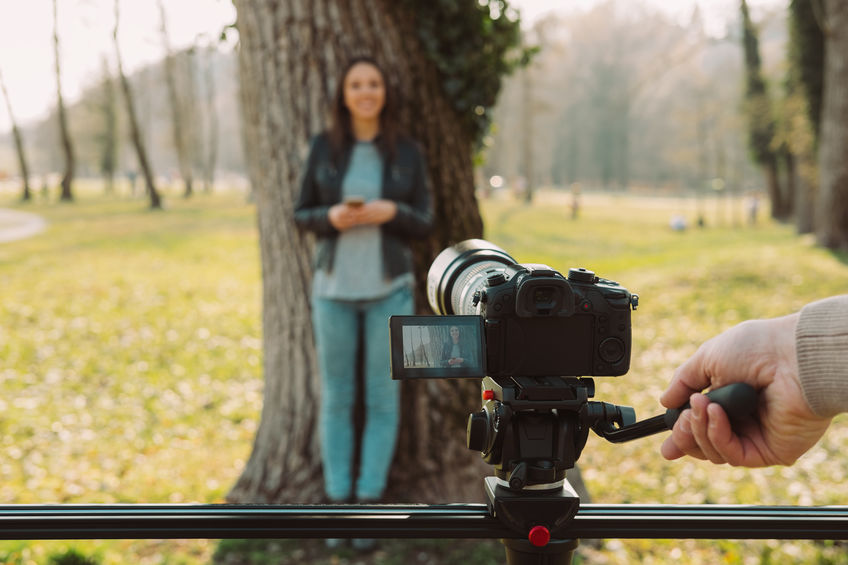
A slider is a smaller version of a camera dolly that you would see in Hollywood movies. These are great for adding movement to your shots.
Companies like Neewer make reasonably priced sliders, but there are some cons to these products. They usually are built for smaller, lighter cameras. Using a larger camera is doable, but it can cause a lot of unwanted shakiness.
This is a great addition to have in your tool kit, but not one that is needed heavily. You’ll also want to keep in mind that you will need a compatible tripod head that will fit on the slider base.
Companies like Edelkrone and Kessler make heavy-duty sliders that are also motorized, but this will come with a larger price tag.
Check out the FilmDaft guide to the best sliders at different price ranges.
Gimbal – moderate priority
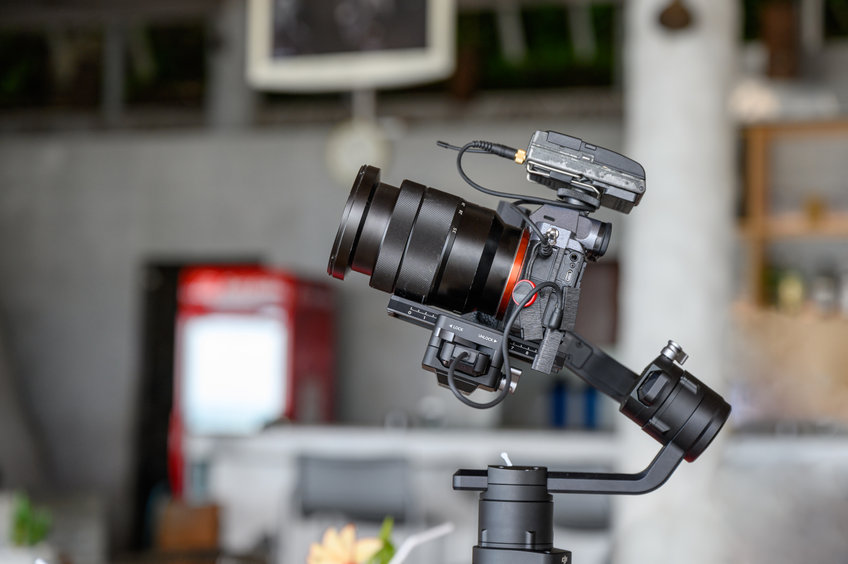
Gimbals have become extremely popular over the years as it allows filmmakers to add a lot of movements to their shots.
Alternatively, you can choose a glidecam instead. Check out our guide to gimbals vs glidecams here.
Companies like DJI have come out with products like the Ronin-S and Ronin-SC that give budget filmmakers the ability to create dynamic shots.
A gimbal can’t replace a tripod, so this will be a tool to add to your kit rather than relying on it entirely.
These are great for action shots like you’d see on a slow-motion skateboard clip, walk and talks, and corporate b-roll.
Check out our guide to some of the best gimbals on the market today.
Jib – low priority
A jib, otherwise known as a camera crane, is a great way to get dynamic shots from higher or lower angles that would otherwise be difficult to achieve.
I personally own one of these and hardly use it.
Most affordable jibs are not large enough to achieve a great result for higher angles, so it might be better as a rental or finding an alternative method.
Sample shopping lists
This is a lot of information to take in, so let me provide some sample suggestions. This isn’t a definitive pricing list.
Also, don’t be intimidated by the pricing or length of these lists. Most of these items can be slowly added to your kit over time. I’ve been adding items for over 10 years now.
This is just an example of what you likely would need and what it could reasonably cost for all of these items.
Bare necessities shopping list ($1,000 to $3,000)
You only want what is truly needed to get started.
- Camera
- Zoom lens 18-75mm range
- Media storage
- Camera batteries and chargers
- Camera bag
- Basic tool set – screwdrivers, allen wrenches, etc.
- Audio
- On-camera 3.5mm microphone
- Batteries for mic
- Headphones
- Lighting
- Cheap kit that comes with 3 lights, stands, and sockets
- Extra light bulbs from hardware store
- Extension cords
- Rigs
- Tripod
Essentials ($5000+)
You can afford to spend a little more than the previous list, or you want to add more items from the previous list. You are taking filmmaking or video production very seriously, but still in the early stages.
- Camera
- Set of prime lenses or a higher quality zoom lens
- Media storage
- Camera batteries
- V-mount battery and accessories
- Camera monitor
- Camera bag
- Basic tool set – screwdrivers, allen wrenches, etc.
- Audio
- Audio recorder
- Shotgun mic
- XLR cables
- Headphones
- Cheaper lavalier mics
- Media storage
- Batteries
- Travel case
- Lights
- Standard 3-point lighting kit with LED lights
- Extra lights for backup
- Extension cords
- Sandbags – keep the light stands from tilting
- Diffusion – softboxes, umbrellas, flags, diffusers to reduce or soft light
- Extension cords
- Batteries – if using battery operated lights
- Carrying case
- Rigs
- Tripod
- Rail system w/ accessories
- Gimbal
- Slider
Professional essentials ($10,000+)
You have a larger budget to work with, or you have been adding items over time. Note, you can assume repeat items from previous lists are upgraded to better versions of that item.
- Camera w/ accessories
- Prime lens kit
- Lens adapters
- Camera batteries and chargers
- V-mount or gold mount batteries
- Camera monitor or recorder
- Hand grips/should pad to create shoulder rig
- Follow focus
- Matte box
- Barn doors for matte box (if needed)
- AA/AAA Batteries
- Recording media – SD, CFast, SSD, etc. – high priority
- Camera bag
- Headphones
- Basic tool set – screwdrivers, allen wrenches, etc.
- Tapes – masking, painters, gaffers, etc
- Audio
- Field audio recorder
- 1-2 shotgun mics
- XLR cables
- Headphones
- Lavalier mics
- Recording media
- Batteries
- Travel case
- Lighting
- Light kit
- Extension cords
- Sandbags – keep the light stands from tilting
- Diffusion – softboxes, umbrellas, flags, diffusers to reduce or soft light
- Batteries – if using battery operated lights
- Carrying case
- Gels – to change the color of the light
- Backdrops – green screens or colored backgrounds
- C Stands – heavy duty stand for holding accessories
- Rigs
- Tripod
- Monopod
- Rail system w/ accessories
- Gimbal
- Slider
- Jib
- Other unlisted items
Conclusion
It is easy to get overwhelmed looking at a list like this because of the influx of information.
As I mentioned before, you do not need to purchase all of these items are once to get you started. It’s helpful to have all of this information in one place so you can refer to it whenever needed.
Be sure to do your research on any items before you purchase. I have purchased several items throughout the years I wish I did not, and a little bit of research would prevent those mistakes.
What did you think of our list? Are we missing anything? Let us know in the comments.

